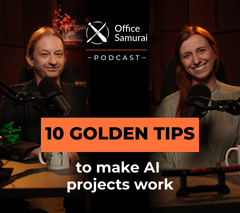Introduction: The corporate exorcist
Andrzej Kinastowski (AK): Konnichiwa welcome to the AI Automation Dojo, the show for anyone who’s ever looked at the workflow and thought “This thing is cursed.”. Our guest today is a practitioner of task mining and he is the closest thing the corporate world has to an exorcist, a corporate exorcist who walks into a company and says “I see dead processes”. We will be asking him what are the rights and rituals of a successful task mining project, how do you convince leadership not to listen to the strange noises coming from the finance department saying that’s the way we’ve always done it? And how do you perform an exorcism on a system when the demon is a 25-step copy-paste workaround everyone is too scared to change? I’m your host Andrzej Kinastowski one of the founders of Office Samurai. Our guest today is Michał Kozubski.
I met Michał almost two decades ago. We’ve been working together in a finance team in a big BPO. I was really happy when three years ago Michał reached out to me and said he’s looking to change his career path. He joined us and since that time he has been doing a lot of different things at Office Samurai as an automation consultant and a business analyst. One of those things is task mining or process mining or however we’re going to be calling it. Michał, welcome to the show.
Michał Kozubski (MK): Thank you welcome and thank you for having me here.
(AK): Tell us why are you the one I’m talking to about productivity mining?
(MK): I assume it’s because during my career I originated from the financial environment, working for outsourcing companies, financial companies, working within accounting. I got acknowledged to the corporate financial and not only financial processes and right now since 3 years I’m investigating those processes even more, looking for improvements or automation opportunities and using the newest technologies to help with that tasks.
(AK): This experience that you have in working in processes, is this something that does help you in those investigations or it doesn’t make that much of a difference?
(MK): Actually the background helps me to understand this translation from the business language to the automation and improvement language. It helps to understand what’s being done because even with the finest automations there is still a little bit of analytical work to do.
(AK): We’re talking about productivity mining today, specifically KYP.ai which is our software of choice. You have been doing a lot of projects with KYP.ai. What is it for you? If you were to briefly say what is KYP.ai and how you’re using it?
(MK): I would gladly refer to your definition. So according to the kinastski principle it’s a very cool tool but at the same time it’s a very useful one. This usefulness, and I see it growing instantly for a few years, is something that helps to understand how the work is really being done within the corporate environments.
Why companies invest in task mining
(AK): Getting this understanding, how does this help companies? Every tool like this is an investment of your time, of your money. Why are companies interested in doing such analysis?

(MK): The companies right now are looking for smart solutions which give them effects straight away and are based on facts and on the real numbers, not on the assumption and procedures which could be outdated, or the data which is invented or made ad hoc, deriving people from their work to make up some numbers and prove that the time they are spending was spent effectively.
(AK): So I understand the tool allows us to see the real world and not what we perceive to be a real world when it comes to business processes.
(MK): Exactly, it will show us the exact environment we are working on. It will show us how the process is really performed because we know from the experience working in a corporate environment that the only people who know how the process is really performed are the ones who are performing it.
The layers of task mining discovery
(AK): What is it that you or the companies who are implementing this kind of tools find? What are the interesting things from your experience that can be found with this kind of analysis?
(MK): Since the KY.ai platform works on I would say a few layers. The first one is the applicational scope. Just recently I’ve encountered a question from a manager “Tell me how many applications you defined as the ones which are used in our team”. When he looked at the list he was quite surprised that there is not just two or three core system. There’s a bunch of other websites and tools that are used during the process.
(AK): The first thing would be the applications. At first you may think that your people are working probably in SAP, maybe a ticketing system, maybe a workflow system of some kind. And then you go deeper and you actually find a lot and a lot of legacy systems, external websites and things like this. What other things? What are the other layers or ideas that you’d be looking into?
(MK): Just getting back to this applications, what is surprising is a lot of information that’s also connected with the processes. Not only people are getting the information from various sources. There is also a lot of communication going on between people. So a lot of emailing flying all around the corporation and a lot of meetings which of course could be more or less productive.
(AK): Most of them are hard to judge when it comes to how productive they are. So for the viewers, it’s important to know that one of the things that you will know is how much time basically your people spend on reading and writing emails on chats. This is information that is quite hard to get in other ways.
(MK): The second layer then apart from the applications is what’s done within that applications. I’m not talking about getting the logs of the core systems, but maybe more general data but from the whole applications environment. So you can easily identify the specific steps you are performing without getting into the personal details or the exact things you are typing in. But at least you can identify what actions are performed within that application. The platform gives you then easy view of how the process is really performed and how the workflow is being constructed and how it looks like in reality.
(AK): So how it actually looks like versus what we have in the procedure or how we think it looks like.
(MK): With the platform capability of recording the actions of the whole team at once we are able to distinguish not only the core process flow but all its variances. We can leave out all the accidents which happens quite often but are caused by an urgent email or urgent information which causes the process to stop.
(AK): I think this is quite important. Sometimes when you look, and this is from my experience working as a lean practitioner, we would watch somebody performing the process and you see that you are unable to watch them for a whole week. You just do a little bit of sampling. Because those productivity mining tools allow us to record so many instances of a process, we can clearly see that this was an outlier. The majority of the process goes in a certain way. I wanted to ask you about those differences that we can see in the data. Sometimes it is about different people in the team performing the process differently even though they shouldn’t, but sometimes it is also about the same process having a few different variants for a few different types of cases or special occasions.
(MK): Exactly, and then we could clearly identify those different flows, see how often they occur and then focus on those which are most time consuming. Maybe the employees which are performing the process a little bit differently found a better way to perform it, found some kind of the shortcut. Or maybe the other way around, maybe some of the employees are unable to perform the process at it was designed because they have to find out a workaround.
(AK): So it may be that the shorter path is better or maybe it’s just omitting some things that we should be doing but some of the people are not. I have often found both kinds of cases. Sometimes we would have people who just knew how to do things more efficiently. And sometimes we would have a team that is overloaded with work and sometimes they take shortcuts that maybe they shouldn’t. They skip a part of the process where they check something, where they double check something because they find it to be a waste of time, and it may be, but maybe it is a vital part of the process.
Advanced insights and workload balancing
(AK): Are there any other angles of looking at the data or kinds of things that we find looking at the measurements in those tools?
(MK): I think we just scratched the surface of the tool capabilities. There is much more about processes and the technology involved in the processes. Let me just say about the workload. As well there could be a comparison of the workload of the processes performed and aggregated through the whole company or department. We had a case when one of the process was scattered through two or three teams. Simply aggregating it to one of them or two of them made the life easier for everyone because the people were not distracted and had more time to focus on their tasks when the processes were evenly distributed.
(AK): This is something that we saw even when we were working together. People think the managers think that the work in the teams is distributed evenly and maybe if you look at the whole month it is but when you look at specific days different people or different teams have way too much or way too little work. This is something that for me this is one of the biggest ways to save money. Proper workload distribution really allows companies to save money and to finally give people kind of predictable workload.

(MK): And you can have that data aggregated already and you know at the exact time when it’s happening. You can compare them week to week for the almost infinite time and see if the changes you tried to implement are really working.
(AK): Measuring used to be extremely labor intensive. Once we have this automated with tools like this then we can have an ongoing measurement. If I tweak something I can immediately see after even a day or a week did it work, did it make things better, did it make things worse? So I can use it to basically steer operations.
(MK): And without bothering your team which is working hard to invent some numbers. It is way easier, it is a lot less of a burden for the team to use a specialized tool that measures them by itself than to actually put things in an Excel file or use a manual tool where they do have to input what they’re doing. And also the quality of the measurement is way higher.
Improvement suggestions and technology analysis
(AK): Any other layers or levels of the measurement that we should be talking about? We know how the process really looks like, maybe we can think of some kind of improvements. This as well is being done with the help of the KYP.ai platform. Just to let everyone know, the process intelligence tool will not make improvements for you. It will give you data that will help you make improvements but it’s not enough to implement it.
(MK): When we have aggregated a lot of data, real data with real numbers, and see what are the interactions between different various applications and process steps, the platform can analyze it and identify some kind of patterns. Based on that patterns the platform can suggest us the probable solutions we can implement to improve the process. Will it be Robotic Process Automation using Copilot, but even standardizing the process is as well the solution we cannot forget about.
(AK): So the platform gathers all the data, analyzes it and it does make suggestions. It actually gives us things that for sure we need to check. We need to have people who will actually dig deeper but it already gives us ideas on for instance you mentioned RPA, so it gives us some point as “hey I see a process that looks like it could be automated”.
(MK): Unfortunately it doesn’t do all the work for us. There should be some kind of analytical work involved. But we can get those patterns identified.
(AK): One of the things that I was stunned when I first saw it and it is still my favorite chart in KYP.ai is the chart where it shows Ctrl+C / Ctrl+V. Where do people copy data from and where do they paste the data to? This is sometimes crazy stuff that we see. We saw this one process where people were actually copying and pasting data from the same system to the same system just from one transaction to another transaction. What are some pointers from the tool that you saw in your projects that were interesting or maybe the most surprising for you?
(MK): Maybe not that surprising but there still is an extensive use of the Excel and copy-pasting. Not only within the core system but in and out of the Excel file. So there is no data integration and the working on data is performed a lot within various Excel files which fly around the company.

(AK): Another thing that I presume it’s a byproduct of the whole thing but it can be really helpful for a lot of companies, I saw there is also an analysis of like the hardware and software that people are using and how well or how not well it’s working?
(MK): There are like two ways to identify those. The first one is just during the work, it’s so-called the passive time which could indicate the slow response time of the application.
(AK): So basically I’m sitting there looking at the spinning wheel and waiting for it to stop spinning.
(MK): But that is not always the case. For example sitting on a meeting and not clicking and writing notes means that the time is spent passively. But there’s another way called technology pools. This is the overview of the hardware performance. So you can identify the times when your CPU, your network or your machine is slowing down. And compare it with what is actually happening within the process. So you can identify when in the process this burden is higher and what application or what set of action has caused this. With this you can actually go to your IT and show them based on data “my computer is too old” because we can clearly see that it slows down my performance.
(AK): This is something that I have also working for big international corporations for many many years. I had those cases where I would open a ticket saying “Hey my computer is really really slow you need to do something or give me a new one or just fix this one.”. And they would say “No it looks good from where we’re sitting.” We run a few tests and it looks fine.
(MK): Exactly, and there’s no way to communicate because I know it’s wrong they know it’s okay and there’s no data for us. With the tool like KYP.ai you can actually measure it. You can make informed decisions because sometimes it is the hardware or the systems are too slow but sometimes it’s just a user’s excuse. It’s good to have the data to see what’s real and what isn’t.
Business reasons for implementation
(AK): When companies do implement tools like KYP.ai, what are the usual reasons for them to get into such an endeavor? What are they hoping to achieve in the end?
(MK): The most obvious would be savings. The savings could be not only measured in money but as well in the people well-being and the people’s performance.
There is a really tough task in for example outsourcing company to allocate the work performed and the processes performed to the specific customers. When you log it manually you’re never sure if it’s right or not. Another thing is the automation. There are some customers which implement this tool to identify the automation opportunities and have the real data based on the real number of employees actually performing the work for a specific amount of time with all the variations. So this is the good start for building a business case.
(AK): This is something that allows us, and we’ve seen this in practice, it allows us to find automation opportunities even in the teams where the managers think everything that could have been automated has already been automated.

(MK): One of the interesting ways to implement the KYP.ai to the benefit of the employee is to actually give the employee the annual or monthly bonus based on the personal performance. So there is a standard threshold assigned by the company and all the additional effort made by the employee is a bonus, a tangible bonus for the involvement.
(AK): This is something that is done a lot in manufacturing. But in business processes we do not measure performance in such detail. We are only able to measure it on a higher level until we get a tool like this.
(MK): There were no good ways to identify that.
(AK): I had a discussion with one of our customers about another interesting approach and that was actually for the company to measure their BPO. So basically they feel that their outsourcing partner isn’t telling them the whole truth.
(MK): That’s very interesting because I’ve heard something similar but the other way around. One of our customers is currently thinking on implementing KYP.ai to the company affiliates and they are on the way of transitioning the process to the business center. So to measure the processes which are being performed and then having that data and having the real process flows transfer them to the service center.
(AK): That would make a lot of people’s lives easier because you’ve been doing transactions. So you know how big of a mess it can be and how much work it is to actually document what they’re doing. So with this kind of measurement we are basically 100% sure that we know 100% of the work that they’re doing and we have the measurements to know how much work it takes. So we get rid of a lot of discussions about yeah this takes three minutes no it takes four minutes.
(MK): Yes and you can run it and perform it on the whole team at once.
Implementation challenges: People, process, technology
(AK): There’s many reasons to implement them and we have talked extensively about what a company can gain. I wanted to switch tracks now and talk about the challenges because it cannot be that easy. What are the main challenges when it comes to introducing those tools into the company?
(MK): As far as the process recognition in KYP.ai is described by people, process and technology, the same gets with the difficulties. It’s all about people, then processes and then the technology, actually in the same order.
The people challenge: The big brother factor
(AK): Let’s start with people.

(MK): The good communication and telling why are we trying to implement the platform, what we would like to achieve and how it really works is key. Because that’s the first thing when people think about using KYP.ai platform mainly a lot of them thinks “okay we’ll be we’ll live in a big brother soon, everything will be recorded and we will be like on an electrical leash”.
(AK): I can understand that nobody likes being measured. How do we work with that?
(MK): This is again the difference between the world of manual labor and office work. It is about showing people why we’re doing this and what exactly we’re going to be measuring. It’s quite important for people for instance to know that we can and we will blacklist private stuff. So if somebody goes on their Gmail the tool will be blind to that. They need to know that if they go on Facebook the tool will not be looking at to what they are looking on on the Facebook page. What is more even if you are using your private applications, the tool will not recognize which one you use.
(AK): But to show them and I think this is really neat because there is this individual dashboard.
(MK): Exactly. That’s the good thing that is there. So there is a possibility to show the employee what kind and which data is actually being collected. So he can always go to his own dashboard and see what was captured from his work. We’re not capturing the exact things he was typing in but only the actions which are needed to perform the process and which are needed to meet the goals we already communicated.
(AK): So they can see for themselves all the data that the tool is gathering on them and they can clearly see yeah I have been to Facebook for 15 minutes and it’s not there.
(MK): This had a really good effect actually because I’ve seen it many times that the first days of using this the KYP.ai platform some of the employees were so scared that they tend not to have any breaks at all because they feared they are being measured. But that cools off after a few days and then the life is going back to normal.
(AK): And I think it’s also really important when it comes to communicating to the employees is that you really need to tell them the truth about why you’re doing it. You cannot tell people one thing and then do another because that’s going to be basically the end of your measurement. People’s creativity when it comes to cheating the system is endless.
(MK): At the very end the KYP.ai platform is just a tool, maybe a multi-tool, maybe a really sophisticated one, but you can compare it to a hammer which we can use to build something or to smash something at the same time.
The process challenge: Analysis paralysis

(AK): That would be the main challenge with people. Processes, what would be the challenges when it comes to the processes?
(MK): We have to keep in mind that the process defined and recognized by the KYP.ai platform consists of the steps which are defined within that. There is a need to have a look at the inventory and define them correctly. I’ve seen a lot of misunderstanding when trying to set up the platform. Sometimes the processes were too general or the other way around, each of the process variant was defined as a separate process.
(AK): So I understand what you’re saying is it’s not a magical tool that you can just turn on and then it’s going to tell you the truth. You need to put work into setting the processes up so that the tool can properly understand what people are doing and based on that give you the insights.
(MK): This is why the analytical work is involved. It’s not like the magical wand that you say “okay do me do the job and just wait for the results”.
(AK): So when you implement it you need analytical work to set it up properly so the measurements make sense. And then once you have the measurements you need to put analytical work into understanding the results and checking those results.
(MK): You need to know what you’re looking for.
The technology challenge: IT security and remote work
(AK): And then we have technology. What are the challenges there?
(MK): As the technology advances really fast, we are still facing some kinds of issues when dealing with it. Until now there is no good way of solving the remote connection through the with the customer systems for example. It’s working not that perfectly, meaning if somebody logs into a Citrix or a virtual machine. The thing that kind of connects to the technology is information technology security. I imagine that when you go to them and you tell them “hey so we’re going to install this little agent on everybody’s computer and it’s going to be gathering a lot of data about what they’re doing” I can imagine the first impression is not that enthusiastic. How do we convince them to allow us to do this and make sure that they feel that everything is in order and that the data that the tool is gathering is safe?
There are various ways to secure the data. Not only within the technology itself connecting through the safe protocols. But we can encounter some kind of requests from our customers concerning the privacy and sensitive data protection. There are various ways of data protection, data masking and making sure that nothing which is absolutely needed is being gathered.

(AK): We can set all of it up on prem so it’s not going to the cloud. We can mask certain things, we can anonymize the data. So for instance we know some user did something but we don’t know which user it is. We can aggregate the data so then you can see the data on the level of the team but not particular people.
(MK): This enables using the KYP.ai platform even in the payroll department. This is not a really easy one to cope with because there is a lot of personal data. The key is here to define what do we want to achieve with the tool.
(AK): You can have it deployed in your own infrastructure and you can use it as a cloud solution. Which one of those are customers using most?
(MK): To my surprise even those who were leaning to the on-prem deployment first tend to decide to deploy in the cloud
New AI features: Concierge
(MK): There are some additional features coming in. When using the cloud deployment you can get access for example to the one of the newest features in KYP.ai, so this KYP Concierge. You can have your personal assistant. If you have access to the dashboards you can get the assistant to translate it from the technical data to the management or even create a business case from the data you filter your dashboards on.
(AK): That should make a lot of people’s lives easier, especially the ones that are not that deep into data analysis.
(MK): What is more this Concierge is available as well on this personal dashboards.
(AK): So I can ask it “How did I do yesterday compared to the day before”?
(MK): Get some hints, some fun facts.
(AK): Another thing when it comes to new features that I am quite excited about is that they plan to have a feature or they’re building a feature where based on the data and analysis of the process you can generate prompts for an AI agent that will be performing this process. I’m on the fence, I don’t know if it will really work but it sounds like another cool idea that could potentially save us some of the trouble.
Conclusion
(AK): Michał thank you for sharing your experience with us. It is quite exciting what’s going on when it comes to productivity mining. The adoption the level of adoption of those technologies is really skyrocketing. Thanks again and maybe in some time we can meet again and see what new and interesting things KYP.ai gave us to play with.
(MK): It’ll be a pleasure. Thanks.
(AK): And that’s our time. The spirits have been quieted, the inefficiencies have been exposed. We made this episode in cooperation with KYP.ai, our first choice for productivity mining. Dōmo arigatō to all you listeners for tuning in. A massive thank you to our guest exorcist Michał Kozubski. And to the irreplaceable Anna Cubal producer. This was recorded at Wodzu Beats Studio. Until next time don’t let evil processes drag you to corporate hell. Mata ne.




